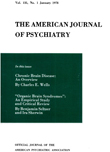METHODS OF ADMINISTRATION OF SUCCINYLCHOLINE DICHLORIDE IN ELECTROSHOCK THERAPY WITH A DESCRIPTION OF A SIMPLE AND MODIFIED TECHNIQUE AND A SUCCINYLCHOLINE DICHLORIDE TEST
Abstract
1. Succinylcholine dichloride (SCC) is a valuable adjunct in electroshock therapy.
2. SCC is one of the best muscle relaxants presently available.
3. A number of methods of administering it are outlined. Our own is described and the more important technical points discussed.
4. We have devised a simple test, which has made it possible for us to determine, at the time of the first treatment, the therapeutic dose required for the best muscle relaxation.
5. Routinely with all patients undergoing electroshock therapy, our aim has been to cause only partial paralysis by using small doses of SCC. However, when used in the presence of fractures, we advise larger doses so that a complete, or nearly complete, muscular relaxation to the point of temporary paralysis is produced.
6. We have not had a single fracture in 300 patients treated with our method.
Access content
To read the fulltext, please use one of the options below to sign in or purchase access.- Personal login
- Institutional Login
- Sign in via OpenAthens
- Register for access
-
Please login/register if you wish to pair your device and check access availability.
Not a subscriber?
PsychiatryOnline subscription options offer access to the DSM-5 library, books, journals, CME, and patient resources. This all-in-one virtual library provides psychiatrists and mental health professionals with key resources for diagnosis, treatment, research, and professional development.
Need more help? PsychiatryOnline Customer Service may be reached by emailing [email protected] or by calling 800-368-5777 (in the U.S.) or 703-907-7322 (outside the U.S.).



